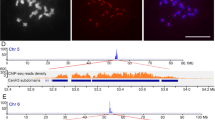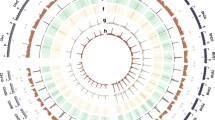Abstract
Centromeres are indispensable functional units of chromosomes. The evolutionary mechanisms underlying the rapid evolution of centromeric repeats, especially those following polyploidy, remain unknown. In this study, we isolated centromeric sequences of Brassica nigra, a model diploid progenitor (B genome) of the allopolyploid species B. juncea (AB genome) and B. carinata (BC genome) by chromatin immunoprecipitation of nucleosomes containing the centromere-specific histone CENH3. Sequence analysis detected no centromeric satellite DNAs, and most B. nigra centromeric repeats were found to originate from Tyl/copia-class retrotransposons. In cytological analyses, six of the seven analyzed repeat clusters had no FISH signals in A or C genomes of the related diploid species B. rapa and B. oleracea. Notably, five repeat clusters had FISH signals in both A and B subgenomes in the tetraploid B. juncea. In the tetraploid B. carinata, only CL23 displayed three pairs of signals in terminal or interstitial regions of the C-derived chromosome, and no evidence of colonization of CLs onto C-subgenome centromeres was found in B. carinata. This observation suggests that centromeric repeats spread and proliferated between genomes after polyploidization. CL3 and CRB are likely ancient centromeric sequences arising prior to the divergence of diploid Brassica which have detected signals across the genus. And in allotetraploids B. juncea and B. carinata, the FISH signal intensity of CL3 and CRB differed among subgenomes. We discussed possible mechanisms for centromeric repeat divergence during Brassica speciation and polyploid evolution, thus providing insights into centromeric repeat establishment and targeting.







Similar content being viewed by others
References
Beilstein MA, Nagalingum NS, Clements MD, Manchester SR (2010) Dated molecular phylogenies indicate a Miocene origin for Arabidopsis thaliana. Proc Natl Acad Sci U S A 107:18724–18728
Belyayev A (2014) Bursts of transposable elements as an evolutionary driving force. J Evol Biol 27:2573–2584
Cheng Z, Dong F, Langdon T, Ouyang S, Robin BC, Gu M, Blattner FR, Jiang J (2002) Functional rice centromeres are marked by a satellite repeat and a centromere-specific retrotransposon. Plant Cell 14:1691–1704
Cheung F, Trick M, Drou N, Lim YP, Park JY, Kwon SJ, Kim JA, Scott R, Pires JC, Paterson AH, Town C, Bancroft I (2009) Comparative analysis between homoeologous genome segments of Brassica napus and its progenitor species reveals extensive sequence-level divergence. Plant Cell 21:1912–1928
Dong F, Miller JT, Jackson SA, Wang GL, Ronald PC, Jiang J (1998) Rice (Oryza sativa) centromeric regions consist of complex DNA. Proc Natl Acad Sci U S A 95:8135–8140
Gong Z, Wu Y, Koblízková A, Torres GA, Wang K, Iovene M, Neumann P, Zhang W, Novák P, Buell CR, Macas J, Jiang J (2012) Repeatless and repeat-based centromeres in potato: implications for centromere evolution. Plant Cell 24:3559–3574
Gorinsek B, Gubensek F, Kordis D (2004) Evolutionary genomics of chromoviruses in eukaryotes. Mol Biol Evol 21:781–798
Hall LE, Mitchell SE, O'Neill RJ (2012) Pericentric and centromeric transcription: a perfect balance required. Chromosom Res 20:535–546
Han J, Masonbrink RE, Shan W, Song F, Zhang J, Yu W, Wang K, Wu Y, Tang H, Wendel JF, Wang K (2016) Rapid proliferation and nucleolar organizer targeting centromeric retrotransposons in cotton. Plant J 88:992–1005
Harrison GE, Heslop-Harrison JS (1995) Centromeric repetitive DNA sequences in the genus Brassica. Theor Appl Genet 90:157–165
Henikoff S, Dalal Y (2005) Centromeric chromatin: what makes it unique? Curr Opin Genet Dev 15:177–184
Houben A, Schroeder-Reiter E, Nagaki K, Nasuda S, Wanner G, Murata M, Endo TR (2007) CENH3 interacts with the centromeric retrotransposon cereba and GC-rich satellites and locates to centromeric substructures in barley. Chromosoma 116:275–283
Hudakova S, Michalek W, Presting GG, Hoopen R, Santos K, Jasencakova Z, Schubert I (2001) Sequence organization of barley centromeres. Nucleic Acids Res 29:5029–5035
Jiang J, Birchler JA, Parrott WA, Dawe RK (2003) A molecular view of plant centromeres. Trends Plant Sci 8:570–575
Jin W, Melo JR, Nagaki K, Talbert PB, Henikoff S, Dawe RK, Jiang J (2004) Maize centromeres: organization and functional adaptation in the genetic background of oat. Plant Cell 16:571–581
Johnston JS, Pepper AE, Hall AE, Chen ZJ, Hodnett G, Drabek J, Lopez R, Price HJ (2005) Evolution of genome size in Brassicaceae. Ann Bot Jan 95:229–235
Koo DH, Hong CP, Batley J, Chung YS, Edwards D, Bang JW, Hur Y, Lim YP (2011) Rapid divergence of repetitive DNAs in Brassica relatives. Genomics 97:173–185
Kraitshtein Z, Yaakov B, Khasdan V, Kashkush K (2010) Genetic and epigenetic dynamics of a retrotransposon after allopolyploidization of wheat. Genetics 186:801–812
Kumekawa N, Hosouchi T, Tsuruoka H, Kotani H (2000) The size and sequence organization of the centromeric region of Arabidopsis thaliana chromosome 5. DNA Res 7:315–321
Lamb JC, Theuri J, Birchler JA (2004) What’s in a centromere? Genome Biol 5:239
Langdon T, Seago C, Mende M, Leggett M, Thomas H, Forster JW, Jones RN, Jenkins G (2000) Retrotransposon evolution in diverse plant genomes. Genetics 156:313–325
Langmead B, Trapnell C, Pop M, Salzberg SL (2009) Ultrafast and memory-efficient alignment of short DNA sequences to the human genome. Genome Biol 10:R25
Lim KB, de Jong H, Yang TJ, Park JY, Kwon SJ, Kim JS, Lim MH, Kim JA, Jin M, Jin YM, Kim SH, Lim YP, Bang JW, Kim HI, Park BS (2005) Characterization of rDNAs and tandem repeats in the heterochromatin of Brassica rapa. Mol Cell 19:436–444
Lim KB, Yang TJ, Hwang YJ, Kim JS, Park JK, Kwon SJ, Kim JA, Choi BS, Lim MH, Jin M, Kim HI, Jong H, Bancroft I, Lim YP, Park BS (2007) Characterization of the centromere and peri-centromere retrotransposons in Brassica rapa and their distribution in related Brassica species. Plant J 49:173–183
Liu Z, Yue W, Li D, Wang RRC, Kong X, Lu K, Wang G, Dong Y, Jin W, Zhang X (2008) Structure and dynamics of retrotransposons at wheat centromeres and pericentromeres. Chromosoma 117:445–456
Lysak MA, Koch MA, Pecinka A, Schubert I (2005) Chromosome triplication found across the tribe Brassiceae. Genome Res 15:516–525
Macas J, Neumann P, Novák P, Jiang J (2010) Global sequence characterization of rice centromeric satellite based on oligomer frequency analysis in large-scale sequencing data. Bioinformatics 26:2101–2108
Malik HS, Henikoff S (2002) Conflict begets complexity: the evolution of centromeres. Curr Opin Genet Dev 12:711–718
Nagaki K, Murata M (2005) Characterization of CENH3 and centromere-associated DNA sequences in sugarcane. Chromosom Res 13:195–203
Nagaki K, Song J, Stupar RM, Parokonny AS, Yuan Q, Ouyang S, Liu J, Hsiao J, Jones KM, Dawe RK, Buell CR, Jiang J (2003) Molecular and cytological analyses of large tracks of centromeric DNA reveal the structure and evolutionary dynamics of maize centromeres. Genetics 163:759–770
Neumann P, Navratilova A, Koblizkova A, Kejnovsky E, Hribova E, Hobza R, Widmer A, Dolezel J, Macas J (2011) Plant centromeric retrotransposons: a structural and cytogenetic perspective. Mob DNA 2:4
Parkin IA, Sharpe AG, Keith DJ, Lydiate DJ (1995) Identification of the A and C genomes of amphidiploid Brassica napus (oilseed rape). Genome 38:1122–1131
Petit M, Guidat C, Daniel J, Denis E, Montoriol E, Bui QT, Lim KY, Kovarik A, Leitch AR, Grandbastien MA (2010) Mobilization of retrotransposons in synthetic allotetraploid tobacco. New Phytol 186:135–147
Santos FC, Guyot R, do Valle CB, Chiari L, Techio VH, Heslop-Harrison P, Vanzela AL (2015) Chromosomal distribution and evolution of abundant retrotransposons in plants: gypsy elements in diploid and polyploid Brachiaria forage grasses. Chromosom Res 23:571–582
Song K, Lu P, Osborn C (1995) Rapid genome change in synthetic polyploids of Brassica and its implications for polyploidy evolution. Proc Natl Acad Sci U S A 92:7719–7723
Talbert PB, Masuelli R, Tyagi AP, Comai L, Henikoff S (2002) Centromeric localization and adaptive evolution of an Arabidopsis histone H3 variant. Plant Cell 14:1053–1066
Tran TD, Cao HX, Jovtchev G, Neumann P, Novák P, Fojtová M, Vu GT, Macas J, Fajkus J, Schubert I, Fuchs J (2015) Centromere and telomere sequence alterations reflect the rapid genome evolution within the carnivorous plant genus Genlisea. Plant J 84:1087–1099
U N (1935) Genome analysis in Brassica with special reference to the experimental formation of B. napus and peculiar mode of fertilization. Jpn J Botan 7:389–452
Vermaak D, Hayden HS, Henikoff S (2002) Centromere targeting element within the histone fold domain of Cid. Mol Cell Biol 22:7553–7561
Wang G, He Q, Liu F, Cheng Z, Talbert PB, Jin W (2011) Characterization of CENH3 proteins and centromere-associated DNA sequences in diploid and allotetraploid Brassica species. Chromosoma 120:353–365
Wang G, He Q, Macas J, Novák P, Neumann P, Meng D, Zhao H, Guo N, Han S, Zong M, Jin W, Liu F (2017) Karyotypes and distribution of tandem repeat sequences in Brassica nigra determined by fluorescence in situ hybridization. Cytogenet Genome Res 152:158–165
Zhong CX, Marshall JB, Topp C, Mroczek R, Kato A, Nagaki K, Birchler JA, Jiang J, Dawe RK (2002) Centromeric retroelements and satellites interact with maize kinetochore protein CENH3. Plant Cell 14:2825–2836
Funding
This study was supported partially by grants from the Youth Science Research Foundation of Beijing Academy of Agriculture and Forestry Sciences (No. QNJJ2016) and the Natural Science Foundation of China (31000538).
Author information
Authors and Affiliations
Contributions
Jin conceived the research and corrected this manuscript, Wang, He, and Zhao conducted cytogenetic experiments. Cai and Guo analyzed data. Zong, Han, and Liu provide and cultivate the plant materials. Wang wrote the article.
Corresponding author
Ethics declarations
Conflict of interest
The authors declare that they have no conflict of interest.
Additional information
Publisher’s note
Springer Nature remains neutral with regard to jurisdictional claims in published maps and institutional affiliations.
Electronic supplementary material
ESM 1
(DOC 884 kb)
Rights and permissions
About this article
Cite this article
Wang, Gx., He, Qy., Zhao, H. et al. ChIP-cloning analysis uncovers centromere-specific retrotransposons in Brassica nigra and reveals their rapid diversification in Brassica allotetraploids. Chromosoma 128, 119–131 (2019). https://doi.org/10.1007/s00412-019-00701-z
Received:
Revised:
Accepted:
Published:
Issue Date:
DOI: https://doi.org/10.1007/s00412-019-00701-z




